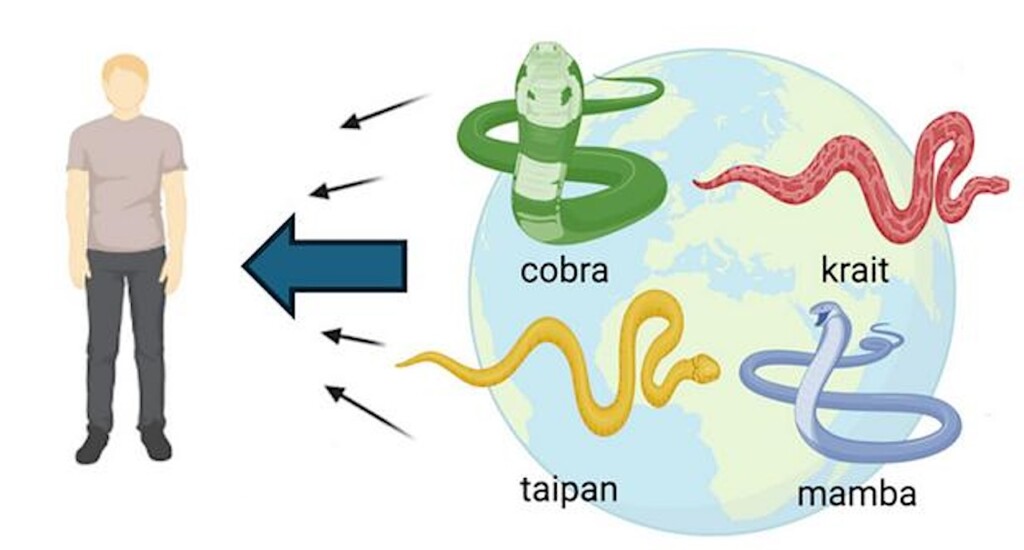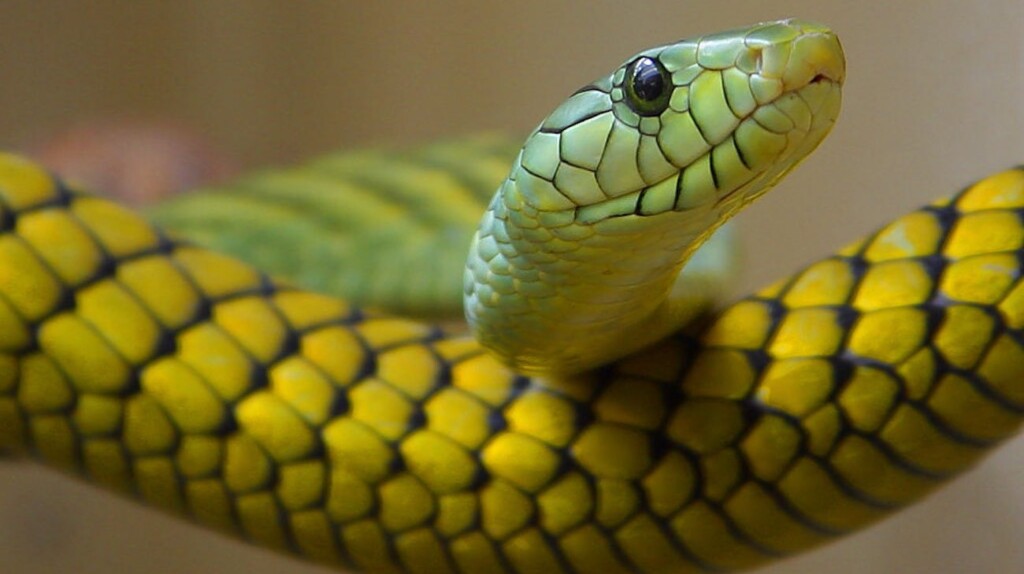 Credit – Glanville et al via Cell Press-CC BY-SA
Credit – Glanville et al via Cell Press-CC BY-SAA revolutionary new antidote neutralizes the venom of 19 of the world’s deadliest snakes, including the black mamba, king cobra, and tiger snakes.
Researchers used antibodies from a human donor with a “hyper-immunity” to snake venom to develop the most broadly effective antivenom to date.
It combines protective antibodies and a small molecule inhibitor and opens a path toward a universal antiserum, according to new research.
How antivenom is made has not changed much over the previous 100 years. It usually involves immunizing horses or sheep with venom from single snake species and collecting the antibodies produced.
While effective, scientists say the process can result in adverse reactions to the non-human antibodies, and treatments tend to be region-specific and only for one species.
While exploring ways to improve the process, American researchers came across someone named Tim Friede who had self-induced a hyper-immunity in himself to the effects of snake neurotoxins.
“The donor, for a period of nearly 18 years, had undertaken hundreds of bites and self-immunizations with escalating doses from 16 species of very lethal snakes that would normally kill a horse,” said study first author Dr. Jacob Glanville, CEO of Centivax Inc, based in California.
After Friede agreed to participate in the study, researchers found that by exposing himself to the venom of various snakes over several years, he had generated antibodies that were effective against several snake neurotoxins at once.
“What was exciting about the donor was his once-in-a-lifetime unique immune history,” said Dr. Glanville in a media release.
“Not only did he potentially create these broadly neutralizing antibodies, it could give rise to a broad-spectrum or universal antivenom.”
To build the antivenom, the research team first created a testing panel with 19 of the World Health Organization’s category 1 and 2 deadliest snakes, a group which contains roughly half of all venomous species, including coral snakes, mambas, cobras, taipans, and kraits.
 Western green mamba (Dendroaspis viridis) by Jon Sullivan, Phototeria Free photos – CC license
Western green mamba (Dendroaspis viridis) by Jon Sullivan, Phototeria Free photos – CC licenseThe researchers then isolated target antibodies from the donor’s blood that reacted with neurotoxins found within the snake species tested.
One by one, the antibodies were tested in mice envenomated from each species included in the panel.
Using that method, scientists could systematically build a “cocktail” comprising a minimum but sufficient number of components to render all the venoms ineffective.
The research team formulated a mixture comprising three major components: two antibodies isolated from the donor and a small molecule.
WOW, LOOK: ‘Fantastic Grandmas’ Have Been Spending Retirement Photographing Venomous Sea Snakes for Science
The first donor antibody, called LNX-D09, protected mice from a lethal dose of whole venom from six of the snake species. To strengthen the antiserum further, the researchers added the small molecule varespladib, a known toxin inhibitor, which granted protection against an additional three species.
Finally, they added a second antibody isolated from the donor, called SNX-B03, which extended protection across the full panel.
“By the time we reached three components, we had a dramatically unparalleled breadth of full protection for 13 of the 19 species and then partial protection for the remaining that we looked at,” explained Glanville. “We were looking down at our list and thought, ‘what’s that fourth agent?’ And if we could neutralize that, do we get further protection?”
SOCIAL MEDIA SCIENCE: Snake Photo Posted on Instagram Leads to Discovery of New Species From the Himalayas
Even without a fourth agent, he says the results suggest that the three-part cocktail could be effective against many other, if not most, snakes not tested in the study.
Since the antivenom cocktail proved effective in mouse models, the team is now looking to test its efficacy out in the field, beginning by providing the antivenom to dogs brought into veterinary clinics for snake bites in Australia.
The researchers also want to develop an antivenom targeting the other major snake family, vipers, to fully cover the more than a million snake bites annually worldwide.
The lead author of the study published in the journal Cell, Professor Peter Kwong of Columbia University, said: “We’re turning the crank now, setting up reagents to go through this iterative process of saying what’s the minimum sufficient cocktail to provide broad protection against venom from the viperids.”
“The final contemplated product would be a single, pan-antivenom cocktail or we potentially would make two: one that is for the elapids and another that is for the viperids because some areas of the world only have one or the other.”
ANOTHER NEW CURE: 13-year-old Successfully Undergoes World-First Treatment to Cure Rarer-Than-Rare Wild Syndrome
The other major goal of the team—which was funded by the National Institute of Allergy and Infectious Diseases of the National Institutes of Health, the National Institutes of Health Small Business Innovation Research program, and the US Department of Energy—is to approach foundations, governments, and pharmaceutical firms to support the manufacturing and clinical development of the broad-spectrum antivenom.
SLITHER THIS GOOD NEWS To Adventure-Seeking Friends On Social Media…
Source link

